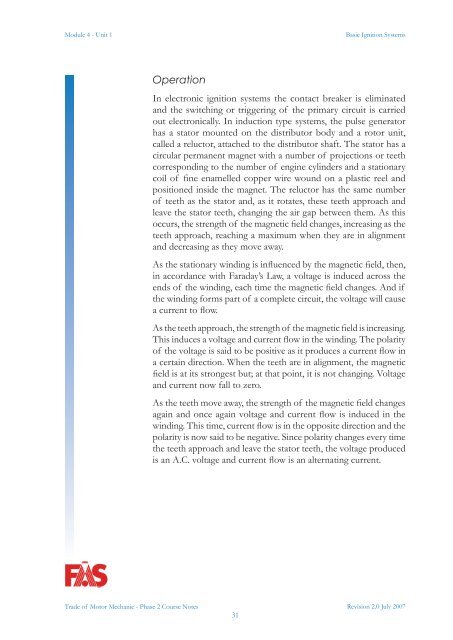Trade of Motor Mechanic - eCollege
Trade of Motor Mechanic - eCollege
Trade of Motor Mechanic - eCollege
Create successful ePaper yourself
Turn your PDF publications into a flip-book with our unique Google optimized e-Paper software.
Module 4 - Unit 1 Basic Ignition Systems<br />
Operation<br />
<strong>Trade</strong> <strong>of</strong> <strong>Motor</strong> <strong>Mechanic</strong> - Phase 2 Course Notes<br />
In electronic ignition systems the contact breaker is eliminated<br />
and the switching or triggering <strong>of</strong> the primary circuit is carried<br />
out electronically. In induction type systems, the pulse generator<br />
has a stator mounted on the distributor body and a rotor unit,<br />
called a reluctor, attached to the distributor shaft. The stator has a<br />
circular permanent magnet with a number <strong>of</strong> projections or teeth<br />
corresponding to the number <strong>of</strong> engine cylinders and a stationary<br />
coil <strong>of</strong> fine enamelled copper wire wound on a plastic reel and<br />
positioned inside the magnet. The reluctor has the same number<br />
<strong>of</strong> teeth as the stator and, as it rotates, these teeth approach and<br />
leave the stator teeth, changing the air gap between them. As this<br />
occurs, the strength <strong>of</strong> the magnetic field changes, increasing as the<br />
teeth approach, reaching a maximum when they are in alignment<br />
and decreasing as they move away.<br />
As the stationary winding is influenced by the magnetic field, then,<br />
in accordance with Faraday’s Law, a voltage is induced across the<br />
ends <strong>of</strong> the winding, each time the magnetic field changes. And if<br />
the winding forms part <strong>of</strong> a complete circuit, the voltage will cause<br />
a current to flow.<br />
As the teeth approach, the strength <strong>of</strong> the magnetic field is increasing.<br />
This induces a voltage and current flow in the winding. The polarity<br />
<strong>of</strong> the voltage is said to be positive as it produces a current flow in<br />
a certain direction. When the teeth are in alignment, the magnetic<br />
field is at its strongest but; at that point, it is not changing. Voltage<br />
and current now fall to zero.<br />
As the teeth move away, the strength <strong>of</strong> the magnetic field changes<br />
again and once again voltage and current flow is induced in the<br />
winding. This time, current flow is in the opposite direction and the<br />
polarity is now said to be negative. Since polarity changes every time<br />
the teeth approach and leave the stator teeth, the voltage produced<br />
is an A.C. voltage and current flow is an alternating current.<br />
1<br />
Revision 2.0 July 2007
















